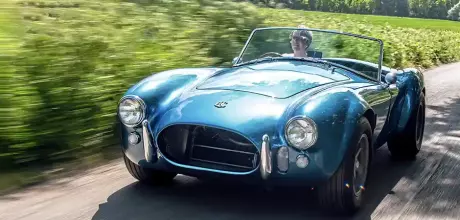1967 AC 289 Sports
The 1967 AC 289 Sports wears no Cobra badging, but it sang the swansong for the original speedcrazed snake. Just 27 were made – we drive the final right-hand-drive example built.
Words EMMA WOODCOCK
Photography IAN SKELTON
Fangs for the Memories Is the AC 289 Sports the ultimate Cobra iteration?
A V8 AC roadster, but not a Cobra – we drive the enigmatic 289 Sports
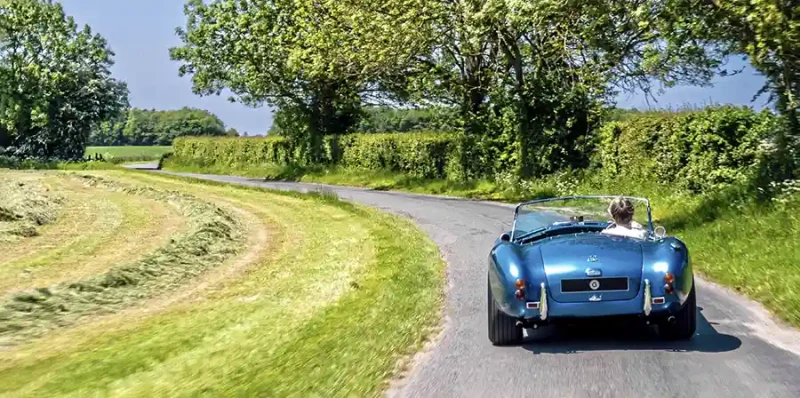
Ka-BOOM. Thunder claps through the 1967 AC 289 Sports. The seat shivers and my sternum aches under the weight of a chewing idle. Dense sound floods from every direction with warm, rounded texture and bass that I feel as much as hear. One hand hooks around studded wood, my thumb resting against the flared and shining spokes of that iconic steering wheel. The other cracks left then forwards in tight stabs – planed shifter ball still cold in my palm – and punches into first. I hold my hip against sharp weight and the exhaust note grows, then flattens, then hardens as the roadster keens away.
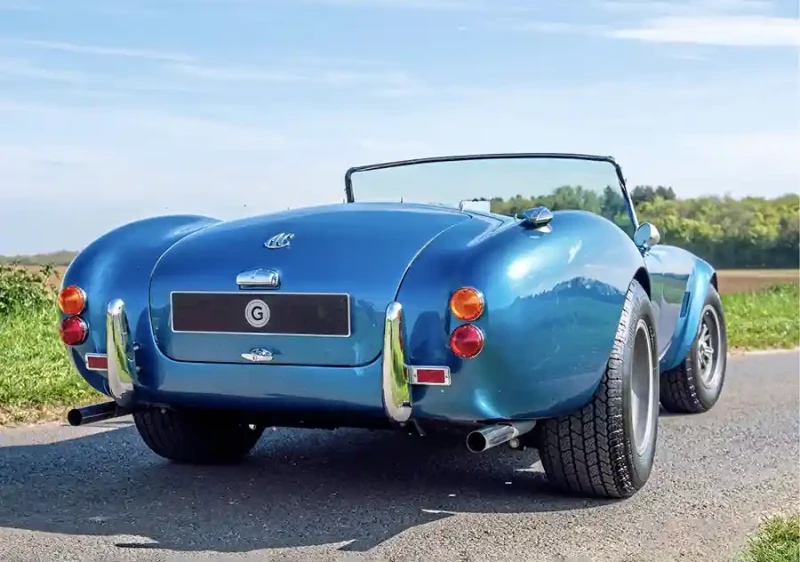
One word forms on my lips. Cobra. Yes it is, and no it isn’t. You see, COB 6124 boasts the Ford 289 Hi-Po V8 that built the MkI and MkII Cobra legends on road and track alike, allied to the strengthened, coil-sprung chassis designed for the 7.0-litre might of the 1965-onwards MkIII Cobra 427, yet it and every other 289 Sports never actually staked a claim on the legendary name. Its Guardsman Blue coachwork and leather-lined cabin go without a single snake motif, confirming through their absence that Carroll Shelby bore no direct involvement with this AC Cars project.

It’s tough pinning any importance to what’s printed on the paperwork when my wrists are aching against tight, heavy steering and a wall of force is wilting my left leg. Then I make it through the gates of Girardo & Co. headquarters and finally let out the clutch. By the time the speedo moves off the stop, I’m driving an entirely different car.
The steering transforms first, freeing and lightening instantly to reveal a quick, precise rack-and-pinion filled with soft-edged information and no slop. I flex my ankle and find a matching throttle but with 312lb ft on tap – much of it available from barely any revs – the Hi-Po just doesn’t need working. Days-long gearing complements the low-stress style. The shift is a short, thick tug that goes precisely where it promises, matching the still sharp clutch, but it can’t set the mood when the lever sees so little use. Second is boundlessly flexible, so I stick with it and let the all-independent suspension define the drive.
Swelling and dropping, like a small boat on a gentle sea, the chassis oscillates and isolates. Precious little makes it through to the cabin when faced with these flowing, major roads. The steering talks but rarely kicks back, never gaining weight, while the upright and plumply-stuffed driver’s seat only telegraphs information when the coil springs drop further through their travel. I catch smooth-edged reports of long, vaguely damped movements to match the occasional nose patter or rear-end bounce, but they barely break through. COB6124 has swaddled me in its languid cohesion.
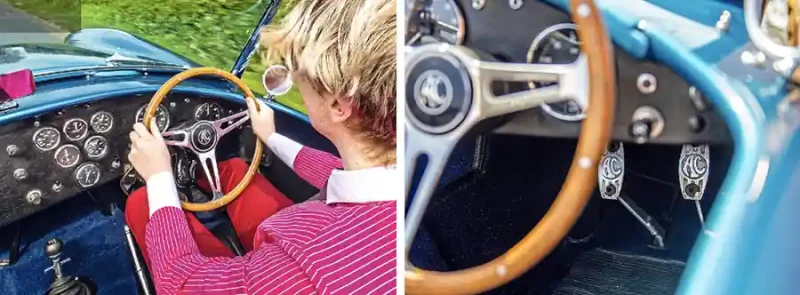
Gazing over sweeping wings, I struggle to match this successor with its 12-year parentage of visually similar AC roadsters. Leafsprung Aces and Acecas – plus earlier Cobras, I’m told – are bucking, bouncing paragons of feedback that hardwire the driver into the road below, whether you want the information or not. I’m pressing the same maker’s-marked pedals as ever, but the 1967 machine isn’t asking me to dance on them.
The 289 Sports is different from its Cobra 427-derived bones. Where MkI and MkII speedy snakes were a joint effort, dropping Shelby’s official Ford V8 supply into a Surrey-built rolling chassis closely related to late Aces, the very first 7.0-litre prototype proved that AC’s narrow frame and transverse leaf springs had hit their limits. Enter Ford, which used one of the first ever computer-aided automotive design processes to create something more sophisticated. Retaining little more than the old frame’s basic longitudinal tube layout, the new version used inch-wider main tubing, substantial bracing and an extra five inches between the frame rails, necessitating new bodywork with wider wheelarches. A larger radiator grille was also installed to improve cooling, ensuring the finished shape shared only a bootlid, bonnet and windscreen with its predecessor. A radical suspension redesign finished the job. Double wishbones and coil springs were installed all-round, complete with Ford designer Klaus Arning’s patented four-link assembly – originally mooted for the 1964.5 Mustang – at the rear. The final version involved input from Shelby’s Bob Negstadt and AC chief engineer Alan Turner to give the big block Cobra a fighting chance of staying on the road.
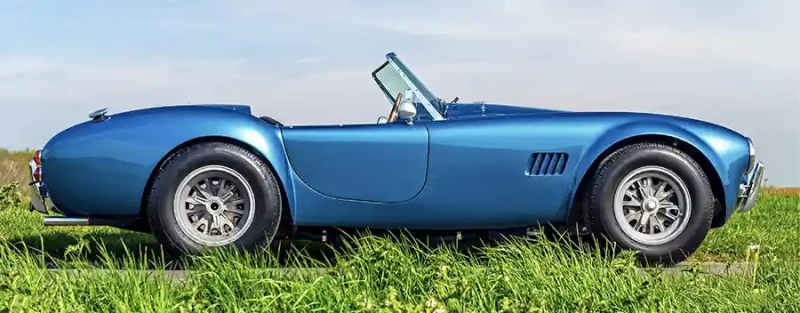
Shelby Cobra 427 production marked a step change in Anglo- American relations. AC still built the bodies and chassis but had no access to the new 7.0-litre lump, leaving the factory with no way to construct complete Cobras and nothing to sell. The Surrey stalwart fast hit on a solution. It was already building MkIII rolling chassis and could still secure the old 4.7-litre Hi-Po, so why not put a pint in a quart pot? The combination was a novelty, never before tried in anything more than test cars and coachbuilt creations. AC put it into production as the 289 Sports. Breaking cover in October 1965, this was a new kind of Cobra, where handling had finally trumped horsepower. Cruising fast and settled, the result is a manners-made-machine. Softedged to the point where an MGB looks fussy by comparison, and scored with a remarkably hushed murmur that allows ordinary conversation, its philosophy stands a mile away from the 427. Subtler styling further distinguishes the British machine. While Shelby developed even larger wheelarches, dabbled with side pipes and employed Halibrand alloys, the 289 Sports specified tighter ‘narrow-hip’ bodywork, as used on two dozen early 7.0 litres, rear-exit exhausts and venerable wire wheels.
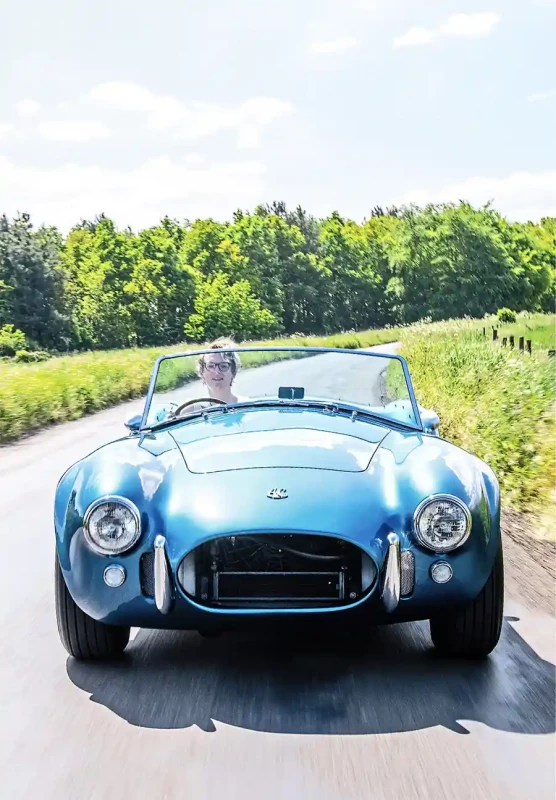
This car is quite civilised, until I push the accelerator as far as I think it goes. Oh. The car stuns forward, slackless and loud. Noise floods back in smoky depth, topped with eddying, oozing fuss and intake stutter that overlay the re-emergence of the breathing exhaust. Only now the beats fire in a quicker, squatter Supermarine Spitfire growl. Underneath, the half-heard bass strafes against walls and trees, echoing back, filling and permeating every sound above.
I lunge again, then again, pushing a little further each time. The exhaust hardens to spits, then splits into a rock-cracking and much louder baritone. Wind slams into the upright windscreen, the soft rear springs sit hard down and the car spits forward and perfectly straight, steering rapidly shedding weight and torque flinging us forwards like I’ve just released an elastic band.
A modest collection of buyers queued up to buy into that experience between November 1965 to February 1969. Interest spanned the globe. With Shelby focused near-exclusively on North American markets, the AC provided by far the easiest route for any other nationality to get their hands on a MkIII, so sales reached Europe, South Africa and Australia. By outlasting the Cobra 427, which ceased production after 1966, three 289 Sports even made it to the United States.
Extras were limited to chromed wires, a radio and a removable hard top, but there was more interest in an option otherwise denied to MkIII owners. Unlike its steroidal sibling, the 289 Sports could be ordered with right-hand drive, accounting for 17 of the 27 cars sold. COB6124 was the last built, making the short hop from Thames Ditton to Victoria Motor Works, Godalming on 29 March 1968. It would spend the next twelve years on home shores, before embarking on an odyssey across the Atlantic.
Illinois, two owners and a respray to red marked the next decade, before COB6124 resurfaced in 1992 as a Shelby 427 S/C impersonator as several did, complete with bonnet scoop, competition fuel tank, a chrome-covered roll bar and stretched rear wheelarches. Painted black and rolling on Halibrand alloys, it stayed that way until a Japanese collector stripped the car back to near-standard in 2013. A return to wire wheels and Guardsman Blue completed the restoration. The next year, the storied machine made it back to the UK for good. A detailed renovation and re-paint followed in 2021, costing almost £70,000. It’s as close to an original 289 Sports as possible and I’m itching to see what that means on challenging roads.
My whole leg lunges through the footwell. The Hi-Po V8 roars dagger sharp and diamond hard. Somewhere out in the great beyond, my toes are pushing the bijou accelerator pedal through the final throes of a travel that puts even a Peter Wheeler-era TVR to shame. Forget fast for a classic. It’s just fast full stop. My seat squab compresses and the engine headbutts harder than ever. Acceleration swells to a frenzy, the exhaust consuming all other sounds as it crests into a molten cry, the tachometer needle flicking through 5000rpm.
I’m a ballerina buckaroo, dancing between delicacy and assertion. The four-square assurance of half-throttle dissolves immediately. Armstrong dampers rebound in messy, extreme lunges; rear coils yo-yo; back tyres bounce. Suddenly the whole car is floating, shoulder-swaying at compressions and cambers, channelling clumsy jet-ski chaos. I twist my wrists ever so carefully, titrating a rim of raw nerves and fretting over what might happen when I hit the brakes.
The all-round Girling disc brakes bite indifferent and vague on first acquaintance, then measurably later when I try for a second impression. A third big stop renders the pedal near-ineffective with brake fade. What little retardation is now available scales to how hard I push. My ankle strains and the 289 Sports slows enough to turn. Pitching forward, an air of weight refills the steering but do not be fooled. The rack is still fast with near-nil latency, pulsing frantic jitters through my fingers whenever the surface is anything short of perfect, so slow hands are vital. Guided to its line, the AC sometimes stays there, gradually building weight to work against.
More often, it doesn’t. Bad surfaces are too much for the loaded chassis and the car’s next moves are a lottery until I learn its patterns. Dips throw the front end into over-exaggerated action, lunging at inside kerbs, yet hitting lumps too early renders the rim useless as the car ploughs straight. Grappling back control, choosing roads a step less challenging, pockmarks pulse frantic jitters through my fingers, spiky and searing with threat, while fast direction changes need a brief pause if I want to avoid numb body roll stasis. So unlike the always eager sports cars that AC built before, COB6124 demands a hard-learnt and particular approach to unlock any speed through the corners. Though far lighter on sophistication and nuance, the sensation reminds me of RS Porsches: a rocket mixed with a chess match. And understeer is the deadly gambit. As my speed grows higher and corners grow longer, push becomes a constant companion. It grows ever more irresistible as each turn develops, eating up available tarmac, until I fold to temptation and lift off. Ever so slightly. The nose tucks, the tail pivots and I realise it might be time to call it a day before I overdo it.
If only that allure had been enough to secure sales. Mirroring America’s underwhelming reaction to the Shelby 427, 289 Sports production never threatened to equal the 62 leaf-sprung Cobras that AC had already sold across Britain and Europe. The competition had caught up, with trans-Atlantic hybrids available from Bristol, Jensen and Sunbeam, not to mention the identically-engined £2364 TVR Tuscan. Slower and costing Porsche 911 money, the £2952 289 Sports lagged behind. Sales gravitated instead to the larger and luxurious Frua-styled AC 428.
The new model staked a yet higher price bracket but offered an optional automatic transmission, choice between civilised fixed-head and convertible body styles and, finally, a way for Brits to enjoy 7.0-litre power in something related to a Shelby 427 chassis. But it wasn’t one of those famous snakes. Legal specifics aside – Carroll sold the trademark to Ford in 1965 – COB6124 undoubtedly is. Wildeyed and grinning, bathed in a fug of brakes, oil and my own sweat, I’m driving a genuine Cobra.
TECHNICAL DATA 1967 AC 289 Sports
- Engine 4727cc V8, pushrod ohv, Holley SIC quad-choke carburettor
- Max Power 271bhp @ 5700rpm
- Max Torque 312lb ft @ 3400rpm
- Transmission Four-speed manual, Salisbury limited-slip differential, rear-wheel drive
- Steering Rack and pinion
- Suspension Front: independent by unequal-length double wishbones, coil springs, Armstrong dampers. Rear: independent by unequallength
- wishbones, trailing arms, coil springs, Armstrong dampers
- Brakes Girling hydraulic discs all round
- Performance Top speed: 135mph
- Acceleration 0-60mph: 5.6 sec
- Weight 1067kg (2352lb)
- Fuel consumption 15mpg
- Cost new £2951 11s (inc. £551 11s purchase tax)
- Classic Cars Price Guide £550,000-775,000
Small-block V8 gets the best from the chassis. From here it could almost be a gentle AC Ace. Why not fit the hood and enjoy a rainy drive? Bodyshape says big-block Cobra. But it isn’t one. Brake fade awaits those who drive hard Steering effort lightens plenty with speed.
‘The steering talks but never kicks back and second gear is boundlessly flexible’
‘Wild-eyed and grinning, bathed in a fug of brakes, oil and sweat, I’m driving a genuine Cobra’
Not seen one? Just 17 right-hand-drive 289 Sports were built.
Rare glovebox not signed by Carroll Shelby Notches help sweaty fingers grip woodrim Heat from 289 V8 fury needs to escape Ford ‘toploader’ ’box shifts with weighty precision.
‘It resurfaced in 1992 as a Shelby 427 S/C impersonator’
KEN MILES, COBRACHARMER EXTRAORDINAIRE
AC Cars aside, the biggest British name in the Cobra and Shelby stories is racing driver Ken Miles. Born in Sutton Coldfield on 1 November 1918, Miles was enchanted by machinery from an early age. He began riding – and crashing – motorbikes aged 11, before buying his first car and enrolling as a Wolseley apprentice four years later.
His competition career burst into life after World War Two with a V8-swapped Frazer-Nash, then hit full bloom after his 1951 emigration to California. His chariots numbered MG, Porsche, Cooper and Ferrari, plus works drives for Rootes.
Then Carroll Shelby poached him. Straddling roles as driver, development engineer and competition manager, Miles helped lead the Cobra, Mustang-based GT350 and GT40 to success. Ken drove Cobras to victory across America and won the 1966 Daytona 24 Hours overall, before placing second in the staged Le Mans ’66 dead heat finish. He was killed that August when the GT40 he was testing failed at 200mph.
‘It’s quite civilised, until I push the accelerator as far as I think it goes. The car stuns forward…’ You won’t find any Shelby badges on this.


